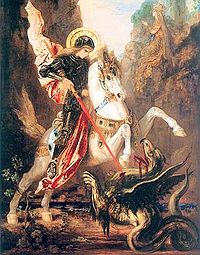Paco: Paco's sister helps her brother
Up to now, you have seen lots of examples of the Genitive Case in English. Do you remember what it consists in and what it is used for? Don't you worry if you can't remember it now, because in this topic we are going to study it in detail! Let's begin!
Remember! Paco is studying the Genitive Case this week. He finds it difficult. So, he has asked her sister Sonia for help and Sonia is helping him by reading a text about Britain's National Days. Do you remember those days?
- Scotland's National Day is Saint Andrew's Day (30 November).
- Saint David's Day (1 March) is the National Day of Wales.
- England's National Day is Saint George's Day (23 April).
- Saint Patrick's Day (17 March) is an official Bank Holiday in Northern Ireland.
She is using the following passage about the legend of St. George to help his brother. Read the passage.
St. George was a Roman soldier who travelled for a long time until he arrived in Libya. There he met a hermit who told him that everybody in those lands was really anguished since a dragon had long ravaged the whole country.
The hermit told him that the dragon demanded the sacrifice of a young woman and that there were few women left, for all the young girls had been killed. The only girl who remained was the king's daughter. The old man assured that if they could not find a knight who could kill the dragon, the princess would be killed by the dragon the following day. According to the hermit, if a knight could defeat the dragon, the king of Egypt would let her daughter marry him.

|
| By Gustave Moreau. Public Domain |
When St. George heard this story, he decided to try to kill the dragon and save that young woman. Thus, the following day he left for the valley where the dragon lived. Near the valley, he could see a little procession of women. He approached them and they told him that the princess was going to the place where the dragon would sacrifice her. However, he persuaded the princess to go back to the palace. Then he entered the valley and looked for the dragon.
When the dragon saw him it came out of its cave. It had a huge head and its tail was at least fifty feet long. But St. George was not afraid. He struck the monster with his spear, hoping he would wound it.
The
dragon's scales* were very hard and the spear broke into lots of pieces
and St. George fell from his horse. He recovered his strength quickly
and attacked the dragon again. He took his sword and managed to plunge it into the dragon's body, just under one of its wings where there were no scales. The dragon fell dead at his feet.
After reading the text, say if the following sentences are true or false.

|
| By Bill Barber. C. Commons |
Verdadero Falso
Verdadero Falso
Verdadero Falso

|
|
|
April 23: Saint George is not only the patron saint of England, it is also the patron saint of of Aragon, Catalonia, Ethiopia, Georgia, Greece, Lithuania, Palestine, Portugal, and Russia, as well as the cities of Amersfoort (Netherlands), Beirut and Bteghrine (Lebanon), Barcelona and Cáceres (Spain), Ferrara and Genoa (Italy), Freiburg (Germany), Ljubljana (Slovenia), Gozo and Qormi (Malta), Pomorie (Bulgaria), Lod (Israel) and Moscow (Russia). So, April 23 is a holiday in many places worldwide.
Remember to use the robot whenever you doubt how to pronounce a word, phrase or sentence.
 |
| Click here to use Mike |
Now that we've briefly remembered what the Genitive Case is, it's time to have a deep look at how it is formed in English. Let's see it in the next section.